Wednesday, May 31, 2006
Tuesday, May 30, 2006
Winchester Mystery House
Our story begins in September 1839 with the birth of a baby girl to Leonard and Sarah Pardee of New Haven, Connecticut. The baby’s name was also Sarah and as she reached maturity, she became the belle of the city. She was well-received at all social events, thanks to her musical skills, her fluency in various foreign languages and her sparkling charm. Her beauty was also well-known by the young men about town, despite her diminutive size. Although she was petite and stood only four feet, ten inches, she made up for this in personality and loveliness.

At the same time that Sarah was growing up, a young man was also maturing in another prominent New Haven family. The young man’s name was William Wirt Winchester and he was the son of Oliver Winchester, a shirt manufacturer and businessman. In 1857, he took over the assets of a firm which made the Volcanic Repeater, a rifle that used a lever mechanism to load bullets into the breech.
Obviously, this type of gun was a vast improvement over the muzzle-loading rifles of recent times, but Winchester still saw room for advance. In 1860, the company developed the Henry Rifle, which had a tubular magazine located under the barrel. Because it was easy to reload and could fire rapidly, the Henry was said to average one shot every three seconds. It became the first true repeating rifle and a favorite among the Northern troops at the outbreak of the Civil War.
Money began to pour in and Oliver Winchester soon amassed a large fortune from government contracts and private sales. He re-organized the company and changed the name to the Winchester Repeating Arms Company. The family prospered and on September 30, 1862, at the height of the Civil War, William Wirt Winchester and Sarah Pardee were married in an elaborate ceremony in New Haven.
Four years later, on July 15, 1866, Sarah gave birth to a daughter named Annie Pardee Winchester. Just a short time later, the first disaster struck for Sarah, as her daughter contracted an illness known as "marasmus", a children’s disease in which the body wastes away. The infant died on July 24. Sarah was so shattered by this event that she withdrew into herself and teetered on the edge of madness for some time. In the end, it would be nearly a decade before she returned to her normal self but she and William would never have a another child.

Not long after Sarah returned to her family and home, another tragedy struck. William, now heir to the Winchester empire, was struck down with pulmonary tuberculosis. He died on March 7, 1881. As a result of his death, Sarah inherited over $20 million dollars, an incredible sum, especially in those days. She also received 48.9 percent of the Winchester Repeating Arms Company and an income of about $1000 per day, which was not taxable until 1913.
But her new-found wealth could do nothing to ease her pain. Sarah grieved deeply, not only for her husband, but also for her lost child. A short time later, a friend suggested that Sarah might speak to a Spiritualist medium about her loss. "Your husband is here," the medium told her and then went on to provide a description of William Winchester. "He says for me to tell you that there is a curse on your family, which took the life of he and your child. It will soon take you too. It is a curse that has resulted from the terrible weapon created by the Winchester family. Thousands of persons have died because of it and their spirits are now seeking vengeance."

Sarah was then told that she must sell her property in New Haven and head towards the setting sun. She would be guided by her husband and when she found her new home in the west, she would recognize it. "You must start a new life," said the medium, "and build a home for yourself and for the spirits who have fallen from this terrible weapon too. You can never stop building the house. If you continue building, you will live. Stop and you will die."
Shortly after the seance, Sarah sold her home in New Haven and with a vast fortune at her disposal, moved west to California. She believed that she was guided by the hand of her dead husband and she did not stop traveling until she reached the Santa Clara Valley in 1884. Here, she found a six room home under construction which belonged to a Dr. Caldwell. She entered into negotiations with him and soon convinced him to sell her the house and the 162 acres which it rested on. She tossed away any previous plans for the house and started building whatever she chose to. She had her pick of local workers and craftsmen and for the next 36 years, they built and rebuilt, altered and changed and constructed and demolished one section of the house after another. She kept 22 carpenters at work, year around, 24 hours each day. The sounds of hammers and saws sounded throughout the day and night.

As the house grew to include 26 rooms, railroad cars were switched onto a nearby line to bring building materials and imported furnishings to the house. The house was rapidly growing and expanding and while Sarah claimed to have no master plan for the structure, she met each morning with her foreman and they would go over the her hand-sketched plans for the day’s work. The plans were often chaotic but showed a real flair for building. Sometimes though, they would not work out the right way, but Sarah always had a quick solution. If this happened, they would just build another room around an existing one.
As the days, weeks and months passed, the house continued to grow. Rooms were added to rooms and then turned into entire wings, doors were joined to windows, levels turned into towers and peaks and the place eventually grew to a height of seven stories. Inside of the house, three elevators were installed as were 47 fireplaces. There were countless staircases which led nowhere; a blind chimney that stops short of the ceiling; closets that opened to blank walls; trap doors; double-back hallways; skylights that were located one above another; doors that opened to steep drops to the lawn below; and dozens of other oddities. Even all of the stair posts were installed upside-down and many of the bathrooms had glass doors on them.
It was also obvious that Sarah was intrigued by the number "13". Nearly all of the windows contained 13 panes of glass; the walls had 13 panels; the greenhouse had 13 cupolas; many of the wooden floors contained 13 sections; some of the rooms had 13 windows and every staircase but one had 13 steps. This exception is unique in its own right.... it is a winding staircase with 42 steps, which would normally be enough to take a climber up three stories. In this case, however, the steps only rise nine feet because each step is only two inches high.
While all of this seems like madness to us, it all made sense to Sarah. In this way, she could control the spirits who came to the house for evil purposes, or who were outlaws or vengeful people in their past life. These bad men, killed by Winchester rifles, could wreak havoc on Sarah’s life. The house had been designed into a maze to confuse and discourage the bad spirits.

The house continued to grow and by 1906, it had reached a towering seven stories tall. Sarah continued her occupancy, and expansion, of the house, living in melancholy solitude with no one other than her servants, the workmen and, of course, the spirits. It was said that on sleepless nights, when she was not communing with the spirit world about the designs for the house, Sarah would play her grand piano into the early hours of the morning. According to legend, the piano would be admired by passers-by on the street outside, despite the fact that two of the keys were badly out of tune.
The most tragic event occurred within the house when the great San Francisco Earthquake of 1906 struck. When it was all over, portions of the Winchester Mansion were nearly in ruins. The top three floors of the house had collapsed into the gardens and would never be rebuilt. In addition, the fireplace that was located in the Daisy Room (where Mrs. Winchester was sleeping on the night of the earthquake) collapsed, shifting the room and trapping Sarah inside. She became convinced that the earthquake had been a sign from the spirits who were furious that she had nearly completed the house. In order to insure that the house would never be finished, she decided to board up the front 30 rooms of the mansion so that the construction would not be complete - and also so that the spirits who fell when portion of the house collapsed would be trapped inside forever. all over the place, although strangely, they served no purpose. Some believe that perhaps they were added because the old stories say that ghosts like to appear and disappear through them. On a related note, it has also been documented that only 2 mirrors were installed in the house.... Sarah believed that ghosts were afraid of their own reflection.

For the next several months, the workmen toiled to repair the damage done by the earthquake, although actually the mammoth structure had fared far better than most of the buildings in the area. Only a few of the rooms had been badly harmed, although it had lost the highest floors and several cupolas and towers had toppled over. The expansion on the house began once more. The number of bedrooms increased from 15 to 20 and then to 25. Chimneys were installed
On September 4, 1922, after a conference session with the spirits in the seance room, Sarah went to her bedroom for the night. At some point in the early morning hours, she died in her sleep at the age of 83. She left all of her possessions to her niece, Frances Marriot, who had been handling most of Sarah’s business affairs for some time. Little did anyone know, but by this time, Sarah’s large bank account had dwindled considerably. Rumor had it that somewhere in the house was hidden a safe containing a fortune in jewelry and a solid-gold dinner service with which Sarah had entertained her ghostly guests. Her relatives forced open a number of safes but found only old fishlines, socks, newspaper clippings about her daughter’s and her husband’s deaths, a lock of baby hair, and a suit of woolen underwear. No solid gold dinner service was ever discovered.
The furnishings, personal belongings and surplus construction and decorative materials were removed from the house and the structure itself was sold to a group of investors who planned to use it as a tourist attraction. One of the first to see the place when it opened to the public was Robert L. Ripley, who featured the house in his popular column, "Believe it or Not." The house was initially advertised as being 148 rooms, but so confusing was the floor plan that every time a room count was taken, a different total came up. The place was so puzzling that it was said that the workmen took more than six weeks just to get the furniture out of it. The moving men became so lost because it was a "labyrinth", they told the magazine, American Weekly, in 1928. It was a house "where downstairs leads neither to the cellar nor upstairs to the roof." The rooms of the house were counted over and over again and five years later, it was estimated that 160 rooms existed..... although no one is really sure if even that is correct.

Today, the house has been declared a California Historical Landmark and is registered with the National Park Service as "a large, odd dwelling with an unknown number of rooms."
Most would say that such a place must still harbor at least a few of the ghosts who came to reside there at the invitation of Sarah Winchester. The question is though, do they really haunt the place? Some would say that perhaps no ghosts ever walked there at all.... that the Winchester mansion is nothing more than the product of an eccentric woman’s mind and too much wealth being allowed into the wrong hands.
There is no question that we can regard the place as one of the world’s "largest haunted houses", based on nothing more than the legend of the place alone. Is this a case where we need to draw the line between what is a real haunted spot .... and what is a really great story?
Is the Winchester Mansion really haunted? You will have to decide that for yourself, although some people have already made up their minds.
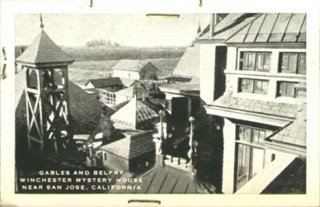
There have been a number of strange events reported at the Winchester House for many years and they continue to be reported today. Dozens of psychics have visited the house over the years and most have come away convinced, or claim to be convinced, that spirits still wander the place. In addition to the ghost of Sarah Winchester, there have also been many other sightings throughout the years.
In the years that the house has been open to the public, employees and visitors alike have had unusual encounters here. There have been footsteps; banging doors; mysterious voices; windows that bang so hard they shatter; cold spots; strange moving lights; doorknobs that turn by themselves.... and don’t forget the scores of psychics who have their own claims of phenomena to report.
Obviously, these are all of the standard reports of a haunted house... but are the stories merely wishful thinking? Reports of ghosts and spirits to continue the tradition of Sarah Winchester’s bizarre legacy? Or could the stories be true? Was the house really built as a monument to the dead? Do phantoms still lurk in the maze-like corridors of the Winchester Mystery House?
I urge you to visit the house if you should ever get the chance. Perhaps that would be the best time to answer the questions that I have just posed to you. I can promise that you will find not another piece of American architecture like the Winchester mansion....
And who knows what else you might find while you’re there?
Thursday, May 25, 2006
Bishop Mule Days - May 25 to 28, 2006
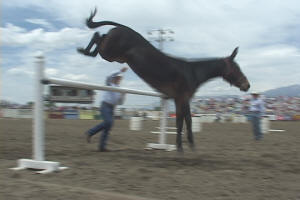
Every year during the Memorial Day Weekend, over 700 Mules compete in 181 events at the Bishop Mule Days Celebration. There is no way to actually describe Mule Days. It is part mule show, part test of skills, and part Wild West show.
Situated on the Tri-County Fairgrounds in Bishop, CA, Mule Days has become an international world class event. Crowds have grown from 200 to over 30,000 fans!
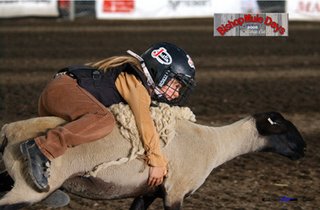
Highlights of the Celebration include the Thursday night concert, featuring Country Music stars, the longest running non-motorized parade on Saturday morning, Steer roping and penning, an event normally reserved for quarter horses, and the Packer's Scramble -- "the wildest, nosiest and funniest event of the weekend".
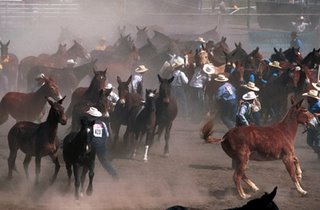
There are also barbecues, country dances and an arts & crafts show. All taking place at the foot of the beautiful Eastern Sierra.

Wednesday, May 24, 2006
Deadwood Season 2 DVD (2005)

The fictionalized western-drama HBO is set in 1870’s in Deadwood, a miner’s stop in the Black Hills of Dakota. While this was a real place and many of the characters were based on actual events the show comes across as a cross between history and compelling drama.
Much was made early on about the cursing, which is prevalent and rather tiresome, but this overlooks the rest of the dialogue which is extremely complex and almost poetic. Some find it hard to believe that people would really talk that way, but on the other hand newspapers and letters of the day use much the same language, cursing aside, making it not much of a stretch to believe that certain people might have spoke in such a style. Either way, this makes the show that much more worth watching and listening to closely.

This is one of the densest series ever shown on television. There is so much going on that DVD is the perfect way to watch it. It takes multiple viewings to catch all the context and sub plots that each episode contains. Rarely has a cast like this been assembled for any film or television show.
The anamorphic 1.78:1 video gives a crisp, clear picture. The color palette is often somewhat dank by design but typically the colors are faithfully represented. The audio is in Dolby 5.1 and it sounds beautiful. This is an expensive DVD set, retailing at close to $100.00. I got mine at Best Buy yesterday for $62.00... for a six disc set that's not that bad.

Tuesday, May 23, 2006
"Spade" Cooley (1910-1969)

"Spade" Cooley went from idolized star to convicted murderer. He was born Donnell Clyde Cooley on December 17th, 1910 from sharecropper parents, one of may cowboy stars from the state of Oklahoma. The family moved to Oregon when he was four. They were very musical and taught the boy to play the fiddle. At the age of eight, he was performing professionally at square dances with his father. He was tagged with the nickname of "Spade" because of his proficiency at playing poker.
The late 30's found him in Los Angeles. He was working as an actor, with bit parts at Republic Studios. Prior to forming his western swing orchestra circa 1942, Cooley was a sideman (on fiddle) with Walt Shrum and the Colorado Hillbillies and Cal Shrum's Rhythm Rangers. Spade also did some fiddling and bit parts in various B westerns. If you watch closely, you can spot him in: MARSHAL OF MESA CITY (RKO, 1939) with George O'Brien; THUNDERING HOOFS (RKO, 1941) and RIDING THE WIND (RKO, 1942) with Tim Holt; DAWN ON THE GREAT DIVIDE (Monogram, 1942) with Buck Jones; IN OLD CHEYENNE (Republic, 1941) and SOUTH OF SANTA FE (Republic, 1942) with Roy Rogers; and LOST CANYON (United Artists, 1943) with William 'Hopalong Cassidy' Boyd. The Cooley band helped out Bing's brother Bob Crosby in SINGING SHERIFF (Universal, 1944). And the group were in ROCKIN' IN THE ROCKIES (Columbia, 1945) which featured mayhem from the Three Stooges and Hoosier Hotshots. Les Adams has Cooley identified in 50+ films, and of that number, 36 are westerns.

'Spade' Cooley came into the limelight during the World War II years with a western swing band with Tex Williams doing vocals. Billing himself as the "King of Western Swing", Cooley had hits such as "Steel Guitar Rag", and "Oklahoma Stomp" (Joaquin Murphey on steel guitar). Spade's signature tune was "Shame On You", which was originally released in 1945 on Columbia's Okeh label with Tex Williams doing the vocal. Spade's hard-drivin' musical style and popularity rivaled that of Bob Wills.
Sidemen during these early years included Joaquin Murphey, Smokey Rogers, Cactus Soldi, Pedro DePaul and Deuce Spriggens. Yodeling wizard Carolina Cotton was also a member of the band. In the Spring of 1945, Spriggens exited to form his own musical group which appeared in several of the Columbia westerns with Ken Curtis and the Hoosier Hotshots (SONG OF THE PRAIRIE (1945), COWBOY BLUES (1946), SINGING ON THE TRAIL (1946)). In 1946, Tex Williams left (some report this was on his own accord while others note that he was fired by Spade). Tex took Smokey Rogers and several other musicians with him and formed the "Western Caravan". In the Summer of 1946, Spriggens dissolved his organization and joined up with Williams.

Cooley formed another group, signed with RCA records and around 1948, hit the TV airwaves on station KTLA in Los Angeles with his own show named "The Hoffman Hayride" which became a ratings hit and lasted for nearly ten years. Cooley sidemen during this later period included Noel Boggs (steel guitar) and Jimmy Wyble (guitar). He had a band which performed Saturday nights at the Venice Pier Ballroom in Santa Monica which packed them in by the thousands. In the late 50's his fortunes waned as tastes in music changed.
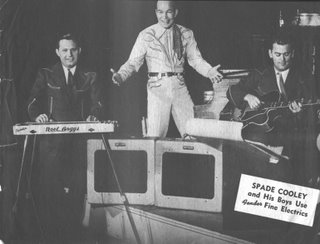
A heavy drinker, Cooley descended into alcoholism and suffered a series of minor heat attacks. In 1961, financial ruin befell him from an investment at Willow Springs, California located in eastern Kern County which was to have been a water theme park. Obsessions with what he believed was the infidelity of his wife Ella May resulted in stomping her to death (in the presence of their 14 year old daughter) wearing heavy cowboy boots after days of drinking at their Willow Springs home. He claimed that he couldn't remember the deed. The resulting trial was a media circus. The jury found him guilty of first-degree murder. The judge sentenced him to life in prison with the possibility of parole.
Throughout his term away from alcohol and drugs, he was a model prisoner. Eight years later, just months before he was to be paroled, Spade Cooley was given a 72 hour furlough to perform at an Oakland police benefit. He finished his last song to a rousing ovation from some 3,000 people in the audience and returned to his dressing room. He suffered yet another heart attack, one of many he endured during his lifetime. This one, Nov. 23, 1969 took his life.
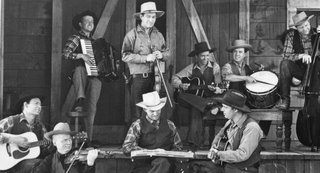
Back row (porch) from L-to-R: Frank Buckley (accordion), Spade Cooley (fiddle), Johnny Weis (guitar), Muddy Berry (drums) and Deuce Spriggens (bass). Front row from L-to-R: Tex Williams (guitar), Gibby Gibson (fiddle), Spike Featherstone (zither?), Smokey Rogers (guitar).
Monday, May 22, 2006
Friday, May 19, 2006
The Land O'Lakes Indian Maiden
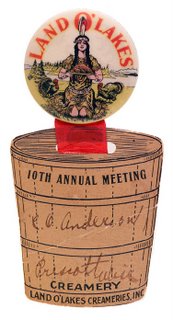

Land O'Lakes Creameries didn't start out with that name. The organization was incorporated on July 8, 1921, as the Minnesota Cooperative Creameries Association. In 1924, the association decided to expand its butter market, and a search was made for an appropriate brand name and trademark. A contest was announced to choose a name. To tie in with the golden color of butter, $500 in gold was offered as prize money.
Two contestants, Mrs. E.B. Foss and Mr. George L. Swift, offered the winning name — Land O'Lakes, a tribute to Minnesota's thousands of sparkling lakes. The name became so popular that in 1926 the association changed its corporate name to Land O'Lakes Creameries, Inc. The now-famous Indian maiden was created during the search for a brand name and trademark. Because the regions of Minnesota and Wisconsin were the legendary land of Hiawatha and Minnehaha, the idea of an Indian maiden took form.

In 1928, Land O'Lakes received a painting of an Indian maiden facing the viewer and holding a butter carton. Lakes, pines, flowers and grazing cows decorated the background. That painting inspired a new design for the butter carton, and remained until the spring of 1939, when it was simplified and modernized by Jess Betlach, a nationally recognized illustrator. Fifty years later, with only minor changes, his design continues on Land O'Lakes products.
Thursday, May 18, 2006
The Harpes: America's 1st Serial Killers?
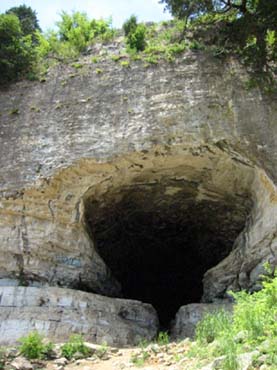
The Harpes
As early as 1760 pioneer families set out from the eastern seaboard colonies toward the Ohio Valley and the frontier of Mississippi and Alabama. One of the most famous early frontiersmen was Daniel Boon of the Carolinas who settled Kentucky. He and his group of pioneers blazed several trails across the Kentucky and Tennessee wilderness into the Mississippi Valley area. Two of those trails were known as the Wilderness Road and Boon's Trace. For many years to come the pioneer settlers used these trails to reach their destinations.
After the American Revolution the lure of rich land and limitless forest drew more and more people into the Mississippi Valley. By 1800 both banks of the Ohio were dotted with settlements and the Mississippi was settled sporadically down to Fort Mobile (Alabama). With more and more settlements, traders began bi-yearly trips back and forth down the Mississippi. It would take them six months to get down the river on the flat boat, and six months to travel by foot or horseback back home, as the flat boats were not made to navigate up river and were torn apart and the lumber used for building houses. The Natchez Trace was the primary route back north and was used by all.

The dangers to the pioneer family and those traveling down the Mississippi in search of trade were not limited to navigation of the muddy waters, or the sturdiness of their vessel. Their trips were dangerous, not only on account of the Indians whose hunting-grounds bounded their track on either side, but also because the shores of both rivers (Ohio and Mississippi) were infested with organized bandits, who sought every occasion to rob and murder. Born in North Carolina, the sons of a Revolutionary War soldier and a Negro slave, Micajah Harpe and Wiley Harpe, also known as Big Harpe and Little Harpe, respectively, are the most infamous and despicable of these bandits. Although historians sometimes contradict themselves on minor details, the basic facts are consistent in every recantation. The Harpe brothers were more than likely the first serial killers on American soil.
Paul Wellman in his 1964 book Spawn of Evil describes Big Harpe as being "above the ordinary stature of man. His frame was bony and muscular, his breast broad, his limbs gigantic. His clothing was uncouth and shabby, his exterior weatherbeaten and dirty, indicating continual exposure to the elements." His larger than ordinary head and a face with "a kind of ferocity that made it exceedingly repulsive." His description of Little Harpe was similar except he had red hair and "bore a hang-dog look of cunning and treachery." As their nicknames hint, Big Harpe was the bigger of the two. Historians agree that Little Harpe was the more scheming of the two and Big Harpe was the brute of evil.

Their recorded history begins in 1795 when they left North Carolina heading west. Two sisters accompanied them, Susan and Betsey Roberts. Susan claimed to be the wife of Big Harpe and Betsy, according to The Outlaw Years by Robert M. Coates, was wife to either of the Harpes, as the "mood seized her, or them." From North Carolina the foursome traveled into Central Tennessee and associated themselves with a renegade tribe of Cherokee Indians. "It was from the Indians," Coates writes that "they learned to strike with cunning and walk warily."
Moses Doss was the first known person murdered by the Harpes. Moses was a friend of the Harpes and lived with them, the Indians, and their women in the wilderness. His mutilated body was found on a trail leading to the Cherokee Indian town of Nickajack. It is said that Micajah Harpe murdered Doss because of the affection he was showing the Harpe women. Apparently the brothers did not mind trading wives with each other, but not anyone else! It was shortly after the murder was discovered that the Harpes learned of Captain Andrew Jackson's (later President of the United States) planned attack on the Cherokees of Nickajack village (in retaliation for the attacks on Nashville) that the Harpes, their women, and four of their Indian friends, removed themselves to their hideout in the Cumberland Mountains.
William Lambuth, a circuit rider preacher for the Methodist Church was the next person who reported meeting the Harpes. In fact he was one of a few men who ever cross their path and lived to tell about it. Wellman details Lambuth's account of their meeting. The Harpes while traveling on the Wilderness Road approached him. After robbing him of his belongings and horse, Micajah Harpe was rifling through Lambuth's Bible when he saw the name of George Washington on the flyleaf, just below the owner's name. Big Harpe asked Lambuth if he had ever seen George Washington. Lambuth replied that he had seen him once in Richmond. Big Harpe commented, "[That] is a brave and good man, but a mighty rebel against the King!" Apparently Big Harpe was impressed that Lambuth had seen George Washington and softened. When the Harpes realized that Lambuth was a preacher, they returned all his belongings. "As the Harpes, by then joined by their women and drove of livestock, made their exit for the woods, Lambuth heard the shout, 'We are the Harpes'!" Thus, Lambuth eventually made his way to the next settlement and related his story which soon was carried up and down the frontier by the many emigrants and traders.
The Harpes were reported as settling down in the young town of Knoxville where they managed for sometime to keep the appearance of honest settlers. They built a cabin on a small tract of land along the Beaver Creek, a few miles west of town. It is here that Little Harpe met and fell in love with Sally Rice, the respectable daughter of a frontier preacher, and they were soon married. The record shows that this façade did not last long and it wasn't long before the Harpes were stealing livestock. When some of their neighbors became suspicious that the Harpes were the thieves and contacted the authorities, a series of mysterious fires destroyed their barns and outhouses. Right after the fires, the Harpes decided it was time to go, and stole a team of fine horses to take with them. Although a posse tracked them down, the Harpes were able to escape and as a result began their lives on the run. In the pioneer days, horse thieving was as bad a crime as murder and perhaps that is why the Harpes from this point forward, never left any of the victims alive to tell the story.
It was not long until the rogue band happened upon a small tavern operated by a man named Hughes located on the bank of the Holston River (five or six miles above Knoxville). It was here that they kidnapped a pioneer name Johnson (his first name was never known) and killed him. Two days later the body of Johnson was found. The murder was so grotesque that few would actually put it into print. The Harpes "had ripped open the body of their victim, performed the revolting act of pulling out his intestines, and filled the cavity with stones, so that it would sink and stay down in the river." This method of getting rid of a dead body was repeated by the Harpes and was later used by other madmen of the era, i.e., Mason, Hare, and Murrell. It became the trademark of the land pirates or river pirates, as they were sometimes known.
After the murder of Johnson, the Harpes "lived like man-eating animals" and had "a cannibal lust for blood". Their next victim was a lone traveler named Peyton. Peyton was a peddler who traveled from settlement to settlement selling his household wares. After killing Peyton they only took his horse and a few of his belongings and left the rest, which clearly shows that their motives were not just for profit. The Harpes had no respect for a kind soul, as was evidence by their murder of Stephen Langford. On December 12, 1789, the Harpes wandered up to a tavern owned by John Farris on the banks of the Rockcastle River in Kentucky. Langford, a guest at the tavern from the previous night was eating breakfast. When Langford noticed two men and three pregnant women, Otto Rothert in The Outlaws of Cave-in-Rock reports, "they seemed objects of pity". When Farris asked if the crude looking group wanted breakfast, one of them answered they had no money. Feeling brotherly love and compassion, Langford bought their breakfast. The innkeeper reported that Langford left with the Harpes on their way through wilderness country. When the Harpes came out of the wilderness Langford was not with them; however his horse was.

It was soon thereafter that two young men named Bates and Paca were unfortunate enough to cross paths with the Harpes. As was normal in those days, when people met on the trails, they often spoken and advised of their plans. When Bates and Paca mentioned to the Harpes they were headed to Logan's Station, that became the Harpes destination as well. Susan Harpe, after her arrest in Russellville, Kentucky, told how both Big Harpe and Little Harpe, after murdering the men, took their clothes from the dead corpses and dressed in them, strutting around and bragging about how pretty they were. It seemed that the rifle shot killed Bates instantly, but when Little Harpe checked Paca, he was still alive, so he split his head with a tomahawk.
As the bodies were being found, word spread through the territory like wild fire. People were afraid of the Harpes. Soon a posse found the two men and three pregnant women and took them back to Stanford (formerly Logan's Station) where they were housed in the jail. While awaiting trial, two of the women gave birth. Trial was set for April 15, but the Harpes had other plans. On March 16 they escaped, leaving their women behind. Shortly after their escape, the third woman gave birth. It wasn't long before the women were released from jail and aided by the "kindly folk made up a collection of clothing and money, and provided an old mare for them."
The Governor of Kentucky presented James Ballenger an order authorizing him to pursue the Harpes and granting permission to cross state boundaries in order to execute this order. The search party separated into two groups, one headed by Henry Scaggs who happened upon the homestead of Colonel Daniel Trabue, a Revolutionary soldier and one of Kentucky's finest gentlemen. While discussing their purpose, the Colonel was awaiting the return of his son, John Trabue, a thirteen year old, who had been sent to the neighbors house to borrow some flour and bean seeds. Time passed and the boy never returned. When the search party went to look for the boy, they found evidence that the Harpes had killed a calf and made moccasins. There was no sign of the boy and it wasn't until several weeks later that his body, cut into pieces, was found in the bottom of a sinkhole. The pioneers of the territory were afraid to step outside of their homes as news of these terrible murders spread. Finally, the Governor of Kentucky passed a proclamation calling for the capture of the Harpes, dead or alive.
Before the proclamation had time to circulate throughout the territory, the Harpes had killed a man named Donley and had butchered another named Stump about eight miles below Bowling Green.The Harpes and their women headed into lower Green River country and worked their way to Cave-in-Rock, Ohio. The number of dead they left in their wake is unknown, but shortly before reaching the cave, they killed a Mr. Potts near the mouth of the Saline River. Cave-in-Rock was known by all to be a haven for outlaws and due to the various search parties looking for the Harpes, all the outlaws returned to their haven, causing it to be a bit crowded. The "Harpes were driven from the cave by the other band of outlaws." It seems that the Harpes were too brutish and bloodthirsty for even the outlaws.
During the short time they were there, they Harpes robbed a flatboat, killing three of its four occupants. The fourth was stripped naked, put on his horse, and pushed from a cliff 100 feet high. The horse and man lay broken on the rough rocks of the river. This outraged their fellow outlaws who were mainly just thieves and not murderers. "It was only the pity that was felt for the women and children that saved the Harpes from being killed." The Harpes were told to leave.
In July 1799, another cruel murder of a farmer named Bradbury was discovered and a few days later a young boy was killed while he was hunting stray cows in the woods. It is reported that the Harpes bashed the boy's head against a tree spilling his brains. Two days later they killed William Ballard. When his body was found it showed signs of disembowelment. After this series of murderers, the Harpes left that area and headed to Harriman Junction. On July 29, they met James and Robert Brassel on a stretch of road near Brassel's Knob. When the Harpes spoke to the Brassels they told them they were bounty hunters looking for the dreaded Harpes. The Brassel brothers quickly told them of the murder William Ballard and the Coffey boy. Needless to say, the brothers were attacked with only Robert getting away.
Robert ran through the woods until he met up with a party of men who were traveling to Knoxville. He persuaded the men to help him save his brother and they reluctantly agreed as they only had one gun to protect themselves. When they returned to the spot, they were horrified to find that James had been beaten to death and his throat cut. They followed the tracks, which indicated the Harpes had gone towards Knoxville. A few miles down the path, the party ran into the Harpes with their women and children. The men were scared and didn't confront them. The Harpes continued on their trek to Tennessee.
The citizens of Tennessee were alarmed as they realized by the murder of John Tully that the Harpes were back in their territory. Every man, woman, and child was carrying a weapon of some sort. Soon Colonel Trabue, father of the young boy that was cut to pieces during one of the Harpes rampages, was arranging messengers to spread the word that the Harpes were back and to call upon the citizens to help in their capture. Each messenger "spread the news along his route, and from every settlement he passed, the report "The Harpes are here" was hurriedly sent out." The warning in a short time had reached every family in Kentucky and many in Tennessee.
Soon the newspapers were publishing accounts of the Harpes crimes. Although the word was out and many were gathering to search for the Harpes, the despicable band of barbarians continued on their homicidal path. The trail of bodies led the posse to believe they were headed toward Russellville (Russell County, Kentucky) to the home of Mr. Roberts, father of two of the women, and when the body of John Graves and his thirteen-year-old son were found they knew they were right. The Harpes, using Graves' own axe, split open the heads of both and threw their bodies in the brush surrounding the house. Soon afterward the bodies of two children were found.
Upon entry into Logan County, the two Harpe men and two Cherokee Indians raided an encampment of settlers, killing all but one man who escaped and ran for help. When he returned to the camp with assistance, the mutilated bodies of seven people, five adults and three children, were found. Apparently Big Harpe did not mind killing children as he killed his own child right in front of her mother. Otto Rothert details the murder as follows: "Big Harpe snatched it - Susan's infant, about nine months old - from its mother's arms, slung it by the heels against a large tree by the path-side, and literally bursting its head into a dozen pieces, threw it from him as far as his great strength enabled him, into the woods."
The Harpes were next seen in Henderson County, Kentucky, where they rented a cabin on a small farm on Canoe Creek. Henderson County was a neighborly community and had just rid itself of several "rascals" and the citizens were unsuspecting of the Harpes until one day when an Indian Fighter named Slover heard the click of a gun while traveling through the woods and turned to see the two Harpe men pointing their rifles at him. Being trained to retreat in situations as this, he was able to get away and tell his neighbors. A day or two later a man named Trowbridge disappeared (and some months later one of the Harpe women told that he was killed and his body sunk in the stream). During that time, the Harpes sent their women and children to one of their many hiding places.
Slover was suspicious of the Harpes and sent spies to watch their day to day activity. Unbeknownst to Slover, the Harpes were aware they were being watched and made their day as ordinary settlers. After the spies retreated, the Harpes were again on the move. In order to be discreet, Big Harpe and Little Harpe disguised themselves as Methodist preachers. About fifteen miles into their journey, they stopped at the home of James Tompkins. Tompkins invited the "preachers" to supper and Big Harpe, to ward off suspicion, said a lengthy prayer before the meal. In making conversation, one of the Harpes asked their host about his supply of venison. Tompkins told the visitors that he had no wild meat, as he had no powder for his gun. Big Harpe removed his powder horn and gave a teacup full of powder to Mr. Tompkins. Thanking their host, they left.
Their destination was to the home of Squire Silas McBee, justice of the peace, who was active in the hunt for them. They went to his house bent on butchering him. It just so happened that Squire McBee had a large pack of hunting dogs and when the Harpes started sneaking around, the dogs attacked and the Harpes withdrew. Next they headed to the home of Moses Stegall, a comrade in various crimes, and found only his wife and four-month-old son home. Also visiting the Stegall home was Major William Love, a surveyor, who was lodging in the loft in the barn. When the Harpes arrived, Mrs. Stegall did not address them by their real names. Major Love had no idea he was about to dine with the predators. Dinner and conversation ensued, with the Harpes bringing up the subject of the murderous outlaws who were prowling around the neighborhood. All three men slept in the loft that night with Major Love being the first to fall asleep. Apparently snoring bothered them as the man was found with his brains bashed in.
The next morning the Harpes asked Mrs. Stegall to make breakfast for them, and when she would first have to tend to her sick child, they volunteered to rock the baby while she cooked. After she placed their breakfast on the table, she went to the crib to check on her baby and found that his throat had been cut from ear to ear. The Harpes did not want the wailing of the broken-hearted mother to disturb their breakfast, so with the same knife, they split her throat, finished their breakfast, pilfered through the house for loot, and set it on fire. They took two horses from the Stegall farm.
After leaving the farm, the Harpes hid in the woods along the trail, hoping that Squire McBee would see the fire, investigate and fall into their trap. Instead, two men Hudgens and Gilmore, came along and the Harpes accused them of murdering the Stegalls. The Harpes told the men they would have to appear before Squire McBee. When the men, thinking they had nothing to fear from Squire McBee, started walking toward McBee's house, Big Harpe shot Gilmore in the back of the head. Hudgens, upon seeing this, started running, but was overtaken by Little Harpe, who beat his brains out with a gun.
The murderers went back to their hiding place watching for McBee but when they saw a party of four or five men heading down the trail toward McBee's house, they realized the fire had been discovered and news was spreading. They made their escape unnoticed. In the meantime, a party was organizing to search for the Harpes, joined by Moses Stegall, who had just learned of the murder of his family. Also joining the search party was James Thompkins, the gentlemen who dined the "preachers". For two days and nights the posse tracked the outlaws until finally they were spotted up on a ridge, standing by their horses. When the villains spotted the possee, they each mounted their horses and went in opposite directions. A search of the area resulted in finding the Harpe camp and only Little Harpe's woman remained. When questioned, she said that Big Harpe had just left after giving each of his women a mount.
The pursuit continued and Big Harpe was found about two miles from camp on a ridge traveling with the other women. When Big Harpe saw his pursuers, he abandoned the women and took out on his own. As the possee prepared to give chase, Leiper, the best shot of all of the possee, borrowed Tompkins gun, as he was having trouble with his gun due to dampness. Soon the posse caught up with Big Harpe. As they advanced, firing shots, it was evident that Big Harpe was shot in the leg. Still the chase continued and as Big Harpe stopped to reload his weapon, "Leiper took unerring aim, and fired - and the same powder that the outlaws had a few days previously given Tompkins, now sped the ball that mortally wounded Big Harpe." The shot severed his spine but he didn't quit fighting. He tried his gun, which wouldn't shoot. Then he grabbed a tomahawk and threw it. The outlaw tried to run but the possee soon caught up with him lying on the ground.

As he lay dying he begged for water and Stegall took his shoe and retrieved water from a nearby brook and gave it to him. Stegall took his knife out and showed it to Big Harpe and told him that he intended on cutting his head off with it to compensate for the murder of his wife and only child. As the posse waited for Big Harpe to die, Stegall took a gun and shot him in the side and death came quickly. Then he proceeded to cut his head off and placed it in a sack. Susan Roberts was forced to carry the head on a stick for miles back to the nearest settlement where it was nailed to a forked tree on the trail near Robertson's Lick and thereafter that point was known as Harpe's Head.
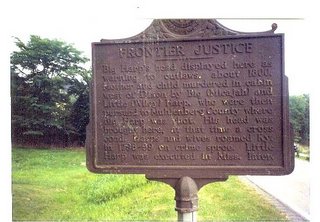
The Sign reads:
"Frontier Justice
Big Harp's head displayed here as warning to outlaws about 1800. Mother and child murdered in cabin west of Dixon by Big (Micajah) and Little (Wiley) Harp, who were then pursued to Muhlenberg County where Big Harp was shot. His head was brought here, at that time a cross road. Harp and wives roamed Ky. in 1798-99 on crime spree. Little Harp was executed in Miss. later."
Wednesday, May 17, 2006
The Wendigo

The American Indians had their own tales of the Wendigo, dating back so many years that most who were interviewed could not remember when the story had not been told. The Inuit Indians of the region called the creature by various names, including Wendigo, Witigo, Witiko and Wee-Tee-Go but each of them was roughly translated to mean "the evil spirit that devours mankind". Around 1860, a German explorer translated Wendigo to mean "cannibal" among the tribes along the Great Lakes.
Native American versions of the creature spoke of a gigantic spirit, over fifteen feet tall, that had once been human but had been transformed into a creature by the use of magic. Though all of the descriptions of the creature vary slightly, the Wendigo is generally said to have glowing eyes, long yellowed fangs and overly long tongues. Most have a sallow, yellowish skin but others are said to be matted with hair. They are tall and lanky and are driven by a horrible hunger. But how would a person grow to become one of this strange creatures?
According to the lore, the Wendigo is created whenever a human resorts to cannibalism to survive. In years past, such a practice was possible, although still rare, as many of the tribes and settlers in the region were cut off by the bitter snows and ice of the north woods. Unfortunately, eating another person to survive was sometimes resorted to and thus, the legend of the Wendigo was created.
But how real were (or are) these creatures? Could the legend of the Wendigo have been created merely as a "warning" against cannibalism? Or could sightings of Bigfoot-type creatures have created the stories. While this is unknown, it is believed that white settlers to the region took the stories seriously. At times, they even took the sightings and reports quite seriously and made it enough of the local culture that stories like those of Algernon Blackwood were penned. Real-life stories were told as well and according to the settlers' version of the legend, the Wendigo would often be seen (banshee-like) to signal a death in the community. A Wendigo allegedly made a number of appearances near a town called Rosesu in Northern Minnesota from the late 1800's through the 1920's. Each time that it was reported, an unexpected death followed and finally, it was seen no more.
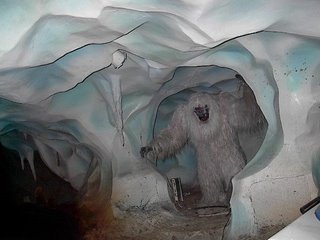
Even into the last century, Native Americans actively believed in, and searched for, the Wendigo. One of the most famous Wendigo hunters was a Cree Indian named Jack Fiddler. He claimed to kill at least 14 of the creatures in his lifetime, although the last murder resulted in his imprisonment at the age of 87. In October 1907, Fiddler and his son, Joseph, were tried for the murder of a Cree Indian woman. They both pleaded guilty to the crime but defended themselves by stating that the woman had been possessed by the spirit of a Wendigo and was on the verge of transforming into one entirely. According to their defense, she had to be killed before she murdered other members of the tribe.
There are still many stories told of Wendigo's that have been seen in northern Ontario, near the Cave of the Wendigo, and around the town of Kenora, where a creature has been spotted by traders, trackers and trappers for decades. There are many who still believe that the Wendigo roams the woods and the prairies of northern Minnesota and Canada. Whether it seeks human flesh, or acts as a portent of coming doom, is anyone's guess but before you start to doubt that it exists - remember that the stories and legends of this fearsome creature have been around since before the white man walked on these shores. The legends had to have gotten started somehow, didn't they?
Tuesday, May 16, 2006
Cottonseed Clark (19??-19??)



COTTONSEED CLARK was the host of several country and Western, musical variety shows on radio in the 1940s, including Hollywood Barn Dance and All Star Western Theater . He appeared in at least one film Smoky River Serenade (1947). I've tried to look for more information on him, like birth date, place of birth, death date, ect. but with no luck. I can't even find his real name. He wrote Texarkana Baby with country/western legend Fred Rose in 1948. Cottonseed Clark recorded an album in 1961 called "Homespun Philosophy" (FOX 3040/SFX 3040). Click here to get a Hollywood Barn Dance broadcast on MP3 and here to get an All Star Western broadcast courtesy of OTRCAT.com
TEXARKANA BABY
Monday, May 15, 2006
Mormon Tea
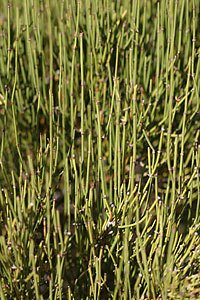
Mormon Tea
Family: Gnetaceae Genus Ephedra Common names: Mormon Tea, Brigham Tea, Cowboy Tea, Whorehouse Tea, Squaw Tea, Canyon Tea Indian names: Tuttumpin (Paiute), Tutupivi (Kawaiisu) Distribution: All of the southwestern United States and Mexico. Found in deserts and on dry mountain sides. Description: a branched broomlike shrub growing up to 4 feet tall, with slender, jointed stems. The leaves are reduced to scales and grow in opposite pairs or whorls of three and are fused for half their length. Male and female flowers, blooming in March and April, are borne on separate plants in conelike structures. They are followed by small brown to black seeds.
Indians
The Indians prepared Ephedra as a tea for stomach and bowel disorders, for colds, fever, and headache. The dried and powdered twigs were used in poultices for burns and ointments for sores. One tribe made a decoction of the entire plant and drank it to help stop bleeding.
Pioneers

Early Mormon settlers, who abstained from regular tea and coffee, drank the beverage made from this plant. A handful of green or dry stems and leaves were placed in boiling water for each cup of tea desired. It was removed from the fire and allowed to steep for twenty minutes or more. To bring out the full flavor, a spoon of sugar or some strawberry jam was added depending on individual taste. Other white settlers used a very strong tea of the plant for the treatment of syphilis and other venereal disease, and as a tonic. It was standard fare in the waiting rooms of whorehouses in early Nevada and California. It was said to have been introduced by a Jack Mormon who frequented Katie’s Place in Elko, Nevada during the mining rush of the last century. Although not as potent as the commercial relatives in China and India, the southwestern species contains enough ephedrine-related alkaloid ingredients to make it functional. The drug ephedrine is a stimulant to the sympathetic nerves and has an effect on the body similar to adrenaline. It has a pronounced diuretic and decongestant effect and was used wherever urinary tract problems occurred.
Friday, May 12, 2006
Jonah Hex Showcase ~ DC Comics (1971-1976)

Jonah Hex Showcase ~ DC Comics
He was a hero to some, a villain to others; and wherever he rode, people spoke his name in whispers. He had no friends, this Jonah Hex, but he did have two companions: one was death itself … the other … the acrid smell of gun smoke.
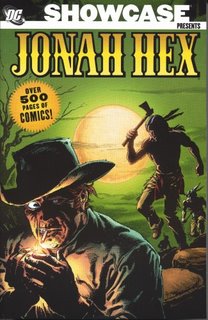
Witness the earliest adventures of DC’s legendary gunslinger as chronicled by writers John Albano and Michael Fleisher with captivating art by Tony DeZuniga, Doug Wildey, Jose Luis Garcia-Lopez and others.
BONUS: The complete adventures of Outlaw, a man out to clear his name, by master comics writer Robert Kanigher and art by Dezniga, Gil Kane and Jim Aparo.
It's not quite clear if Jonah Hex is supernatural or not. Many of the original "Weird Western" Comics from the early 1970's seem to suggest "Twilight Zone" style stories similar to the DC's "Weird War" series. Hex was really more of a Clint Eastwood/Man with no name
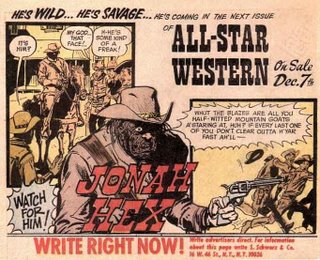 character; a bounty hunter that spoke little dialouge and killed men every issue. Check your local comicbook store or the internet for this DC comics "Showcase" book of reissued Wierd Western/Jonah Hex stories from 1972 to 1976. It Retails for $16.99 and is over 500 pages...
character; a bounty hunter that spoke little dialouge and killed men every issue. Check your local comicbook store or the internet for this DC comics "Showcase" book of reissued Wierd Western/Jonah Hex stories from 1972 to 1976. It Retails for $16.99 and is over 500 pages...
Thursday, May 11, 2006
Country: The Twisted Roots of Rock 'n' Roll by Nick Tosches
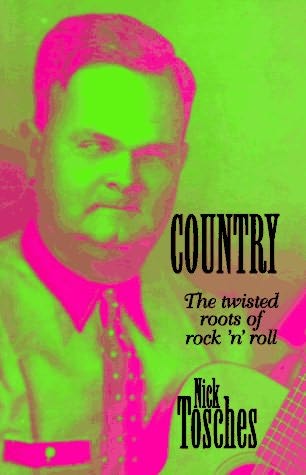
Nick Tosches first book reads like a pile of notes with one chapter and topic jumping to the next without any real continuity, not unlike one of those “bathroom readers” or “book-of-lists” books that are so popular.
Tosches, focusing on sex, racism, drugs, and death, tells country & western's musical legacy through the history of yodeling cowboys, yodeling, Emmett Miller, black-face minstrel shows, black country musicians, sexual metaphors, “coon” songs, the fiddle, the electric guitar, the lap steel, the steel guitar, the pedal steel, Jerry Lee Lewis, Sun Records, western-swing, honky-tonk, rockabilly, the Nashville sound, record labels, Reb Rebel Records, radio stations, disc jockeys, and more. 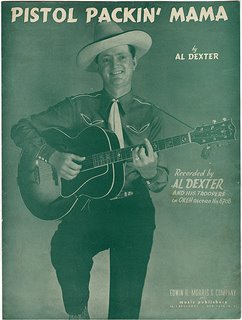
Tosches takes Sun Recording artist Warren Smith’s song “Black Jack David” and traces it all the way back to the birth of Christianity in ancient Rome. I wish it was longer and more in depth becasue I was literally reading this in my truck while stopped at red lights...
Wednesday, May 10, 2006
The Shifting, Whispering Sands (Gilbert/Hadler)

Tuesday, May 09, 2006
Riders of the Whistling Skull (1937)

Riders of the Whistling Skull (1937)
(Black & White) 54 minutes
I love B-Westerns. Usually low budget, aimed at depression-era pre-adolescent audiences, these films are almost always loaded with guns, horses, fights, bad guys, good guys, and sometimes a song or two by real country & western artists if you can spot them. Most B-westerns clock in at around sixty minutes, which makes for great late-night viewing when you think you might not be able to make it for two full hours.
Combining western, mystery and horror elements, Riders of the Whistling Skull stars "The Three Mesquiteers"; Ray "Crash" Corrigan (founder of "Corriganville"), Robert Livingston, and Max "Alibi" Terhune (who carries around his ventriloquist dummy named "Elmer") as they help the daughter of a missing professor on an expedition to "the Lost City of Lukachukai" where her father has disappeared. They find their way to "the Whistling Skull", a strange rock formation shaped like a giant human skull, protected by a mysterious group or Indians and haunted by a tribal curse.
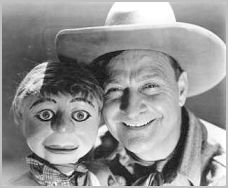
Riders of the Whistling Skull also features famed stunt-man Yakima Cunutt, Chief Thundercloud and according to the Internet Movie Data Base, Iron Eyes Cody in uncredited role. The DVD packaging from Alpha Video claims that the movie was filmed in "the cliffs above St. George, Utah" but it looks like some of it was shot in Red Rock Canyon State Park in California. The picture quality on this disc is not very good but I picked it up for only $4.99 at Best Buy so I can't really expect too much.
Monday, May 08, 2006
The Red Headed Centipede


The Red Headed Centipede is a desert dweller that spends the day tucked away in moist hiding spots to avoid the desert's drying affects. They are often found in rock crevices, under leaf litter, and under rocks, and will sometimes burrow into the ground. Red Headed Centipedes are nocturnal predators that feed primarily upon insects. They are well equipped to avoid being preyed upon. This species of centipede has a tail that looks similar to its head, confusing would-be predators and thus, helping to protect its most vital areas. If it is attacked, it can respond with a very painful or even deadly bite. This species of centipede is quite fast and typically very aggressive. Although the venom of this centipede is not considered deadly to humans, all centipedes have a certain amount of venom in their bites; and while be bitten usually results in nothing more than a very painful wound, some people may be allergic to the venom. Pain from the bite may only last a couple of hours, but it could last as much as a couple of days.
The Red Headed Centipede is one of the world's largest species of Centipede and can reach 6 to 12 inches in length. They may have dark blue, purple, or black bodies with red or orange heads, and attached to each body segment is a pair of yellow legs.
The Red Headed Centipede is a relatively common species found throughout much of the southwestern United States and Northern Mexico.
Sunday, May 07, 2006
The Thunderbird: Myth or Reality?

The Thunderbird....
The strange case of the Thunderbird is unique in the study of unknown animals, because it contains two mysteries in one: the search for a long-lost and probably nonexistent photograph of the creature has virtually eclipsed the search for the creature itself. The Thunderbird is a part of Native American mythology in tribes of the Pacific Northwest and the Great Lakes. These giant, birdlike creatures were said to generate lightning from their eyes and to cause thunderclaps by flapping their massive wings in the sky. There are countless sightings on record of the revered supernatural entity, or a huge bird fitting its description, both by Native Americans and the "white man".
The most celebrated Thunderbird encounter took place in 1890, on the desert sands of what was then the Arizona Territory. Two cowboys had a bizarre confrontation which has varied widely in the telling, but the gist of the story is this: they saw a giant flying bird, shot and killed it with their rifles, and carried its spectacular carcass into town. A report in the April 26, 1890 Tombstone Epigraph listed the creature's wingspan as an alarming 160 feet, and noted that the bird was about 92 feet long, about 50 inches around at the middle, and had a head about eight feet long. The beast was said to have no feathers, but a smooth skin and wingflaps "composed of a thick and nearly transparent membrane... easily penetrated by a bullet." Perhaps the hardest part of this story to swallow is that two horses could manage to haul a dead behemoth like this for any distance.

Sounds like a typical tall tale of the Wild West, and that's probably what it is. But it apparently does contain a kernel of truth. In 1970, Harry McClure claimed that as a boy he knew the two cowboys from the story later in their lives, and they had told him a different version of the events. McClure said the giant bird they saw in the desert actually had a wingspan of more like 20 to 30 feet -- much more reasonable than 160, but still enormous. The two riders shot at the creature, but it was out of range. Their spooked horses refused to chase it, so the men rode into town empty-handed, carrying only news of the one that got away. The Tombstone newspaper printed its highly embroidered version of the cowboy's sighting, which was spared from fading into obscurity by its inclusion in a 1930 book on the Old West.
In 1963, the story came to the attention of writer Jack Pearl, who revived the tale for an article in a pulpy men's adventure magazine called Saga. As if the Epigraph report hadn't spiced up the facts enough already, Pearl liberally embellished the encounter into a dramatic rip-snorter entitled "Monster Bird That Carries Off Human Beings!"Pearl pushed the date of the encounter back to 1886, and he described the witnesses as two prospectors who killed the bird and proudly showed off their trophy in Tombstone. Pearl also added some extra conflict by telling of a how a second Thunderbird snatched up a heckler who had ridiculed the prospectors and flew away with him in its talons. But Pearl's most significant editorialization was this: he said that the Epigraph newspaper story had run with a photograph of the giant bird's carcass, nailed up to a wall with its mighty wingspan unfurled, and a number of men posing next to it for scale. This part of the legend, the Thunderbird photo, has taken on a life of its own. Pearl's fictional account of a photograph of Old West settlers with a big dead bird was picked up and repeated time and again, multiplying and evolving just as it had before Pearl ever got hold of it. In time, people who heard the story began to believe that they had previously seen the photo with their own eyes. Somehow, people felt convinced that they had once marveled at the strange picture in some old book or newspaper, often noting that they didn't realize the significance of the photo at the time, and regretting that they had not kept it. The details might differ from one recollection to the other, with some recalling the bird had feathers and others saying it looked more like a pterodactyl, and some thinking the bird was nailed to a wall and others remembering that it was held with wings outstretch by a large group of men. But no matter what the specifics, each person feels certain his or her memory is true.
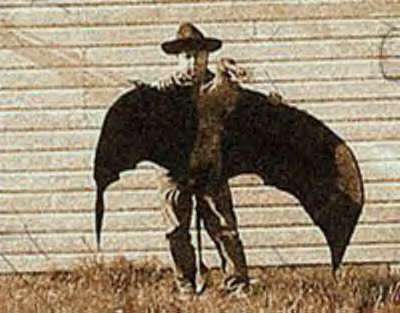
Many have reported that they saw the Thunderbird photo in FATE Magazine, National Geographic, Grit, or some other similar publication, but entire archives of these periodicals have been searched, and no Thunderbird discovered. The experts in the cryptozoology field are no less susceptible to Thunderbird recollections than the common layman, with Ivan T. Sanderson and John A. Keel among those who claim to have once held the photo in their hands. Some accounts of seeing the photo are amazingly precise and hard to disregard. Larry Thomas told Strange Magazine that he saw the photo in a library in the early 1980s, as an adult, in a thin hardcover book of photography from the Old West. He says that he was so fascinated by the picture that he looked at it dozens of times over a four-year period, and he even checked the book out once so he could take it home for his wife to see. It's difficult to tell someone that an experience as vivid as that never really happened, but what is the alternative? What's the word with the Thunderbird? The best explanation for the phantom photo phenomenon is that these are memories of things that never existed. It might simply be that people have read descriptions of the cowboys and the giant bird that were so colorful and evocative that their imaginations created a near-tangible mental image of the scene. As the controversy surrounding "false memory syndrome" has demonstrated, the things we think we recall can be distorted by external suggestion, mismatched fragments of things that did happen, and maybe even debris from the collective subconscious. Some might view this line of reasoning as party-pooping skepticism, but if it's correct, what it reveals about the mysteries of the human mind is way more interesting than any big bird could ever hope to be.



